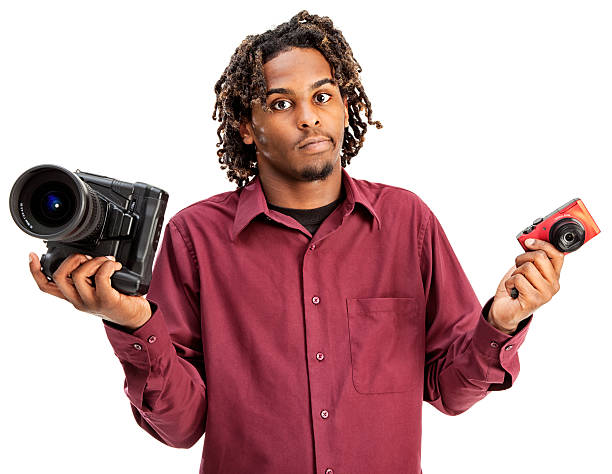A frame is exposed to light one at a time on a roll of film to create an image. When silver halide crystal layers are layered on a plastic ribbon called the film, and when exposed to light, they get darker.
Photographers develop the negatives to produce the actual image for the photograph from these dark captures, which are known as negatives of photographs.
Depending on how long the film roll is in the camera, the camera can take a certain number of pictures. The photographer frequently carries additional rolls of film to take more pictures.
An electronic sensor is used in digital photography to take pictures. Light striking the camera’s sensor creates an image, simulating the way film photography works.
Measuring the resolution of the images on a memory card, known as megapixels, a higher resolution is achieved by employing more megapixels. Instead of making a negative of the image, the electronic sensor used in digital photography records the image as it is.
Film camera or digital camera

Being aware of the differences can improve your photography and encourage discussion among friends about the direction that film is going in. The image sensor used to capture the image is the most obvious difference between film and digital photography.
The film of a film camera has a light-sensitive layer behind the lens. Light strikes the film for a predetermined amount of time when you take a photo. Consequently, the film prints a picture. Rolling the film and putting a fresh, new roll of film in front of the lens is necessary to take a fresh picture.
The most noticeable improvement is in the depth of field. Due to digital sensors’ reduced size compared to 35mm film sensors, most tiny digital cameras have an almost infinite depth of field. Consequently, it is impossible to produce backdrops that are blurred.
A digital camera is nearly always free to use when taking pictures. The pictures are kept in memory that can be deleted, so they can be free-of-charge deleted whenever you choose. The pictures you want to save can also be copied to digital storage devices like hard drives for computers.
There are significant differences between film photography and digital photography. Thanks to developments in digital photography, high-end DSLR cameras now provide a quality that is, in many ways, comparable to film. The topic of the photograph and the balance should both be considered when assessing quality.
Photography on digital vs. film
Digital photography has steadily gained ground on traditional film photography over the last ten or so years. Examining the causes will help. The medium is primarily where film and digital photography diverge. Film, as its name suggests, uses film to take and store photographs.
On the other hand, in digital photography, a digital sensor takes the picture, which is subsequently saved in flash memory.
Some even send the image wirelessly to an adjacent computer instead of using the memory card. The rapid feedback you receive after each picture is among the most important advantages of going digital.
The image you captured can be viewed on an LCD located on the camera’s rear. If you want to check that you’ve obtained the right level of exposure, you may even look at the image’s histogram.
The decision of whether to keep the photo or to take another one is then yours to make. Film photography does not have this option, and the majority of people take one or two extra shots only to avoid a rude surprise during processing.
If you want to reach higher levels, both can be fairly expensive in terms of expense. Compared to digital and film cameras, DSLRs are more expensive. Savings on film gradually offset the original financial cost.
However, film needs to be developed in darkrooms. The most expensive component of film photography is developing and printing the images because you need a special area, chemicals, and equipment for this.
As you might have suspected, dealing with film is a little time-consuming and tiresome. These issues are essentially eliminated with digital. There is software that you may use to repair images you’ve shot or change them to take out unwanted aspects, add special effects, or for any other reason.
Conclusion
It is inevitable that it will transition from film to digital. As digital cameras improve in quality and capabilities, there are fewer and fewer reasons to continue using film. Since so many digital cameras have surpassed film cameras in recent years, any advantage you could have had with film is now outweighed by the advantages of utilising digital.
![]()


